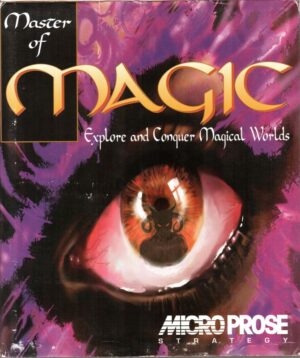Retro Replay Review
Gameplay
Crystals of Arborea unfolds as a classic party-based RPG where you control six adventurers on a quest to save the island kingdom from Morgoth’s chaos. Exploration alternates between a top-down 2D overworld, where you guide your party across forests, swamps, and ancient ruins, and first-person or third-person 3D screens within dungeons and villages. This dual perspective creates a satisfying mix of strategic navigation and atmospheric, on-the-ground exploration. Every new region introduces fresh monsters and environmental hazards, keeping the journey varied.
(HEY YOU!! We hope you enjoy! We try not to run ads. So basically, this is a very expensive hobby running this site. Please consider joining us for updates, forums, and more. Network w/ us to make some cash or friends while retro gaming, and you can win some free retro games for posting. Okay, carry on 👍)
Combat in Crystals of Arborea is turn-based and takes place on a separate battle screen. You manually position each character—whether a melee fighter closing in on orcs, a bow-wielding archer picking off enemies from afar, or a spellcaster unleashing elemental magic. This granular control demands careful planning: terrain matters, ranged units must maintain line of sight, and grouping melee fighters too tightly can leave you vulnerable to area spells. While the lack of auto-battle may feel slow to some modern players, it rewards tactical thinking.
Character progression is straightforward yet engaging. Defeating foes and completing quests yields experience points that boost your party’s attributes and unlock new abilities. You can customize roles—specializing one elf as a master archer, turning another into a blunt-weapon tank, or focusing your mage on fire or ice spells. Side quests pepper the world map, offering valuable loot and occasional new spells, making detours worthwhile. Resource management—stocking healing potions, scouting for treasure chests, and resting at inns—adds another layer of decision-making.
Graphics
For its time, Crystals of Arborea delivers charming visuals with a clear distinction between the overworld and dungeon screens. The 2D map is rendered in bright palette shifts to reflect different biomes—lush greens for forests, ominous purples for corrupted lands. Character sprites are small but well-defined, allowing you to track each party member’s position easily. Enemies range from skeletal warriors to black elves, and each has unique animations that bring battles to life.
When you enter towns or temples, the game switches to a 3D or pseudo-3D perspective, complete with textured walls and decorative tapestries. These areas, though blocky by today’s standards, capture an eerie and immersive ambiance, especially when dim torchlight flickers across the stone floors. Puzzle doors, hidden levers, and rune-inscribed pillars all feel handcrafted, adding to the sense of discovery.
Sound design complements the visuals with a medieval-inspired soundtrack that swells during critical moments, like restoring an elemental crystal or entering a boss chamber. Ambient noises—dripping water in dungeons, distant howls of orcs—heighten the mood. While the audio quality is modest compared to modern titles, it delivers nostalgia and effectively underscores the game’s high-fantasy setting.
Story
At its core, Crystals of Arborea spins an epic tale of divine conflict and the struggle to preserve the world’s balance. Morgoth, the banished god of chaos, has infiltrated mortal realms by corrupting orcs and black elves, turning them into instruments of vengeance. This cosmic backstory unfolds gradually through in-game dialogues, NPC exchanges, and written scrolls discovered in hidden corners of the map.
You assume the role of Jarel, the last Prince of the elf-like Sham-nirs, whose homeland is the final bastion against Morgoth’s encroaching darkness. As you ally with humans, dwarves, and even redeemed orcs, the narrative weaves in themes of unity and sacrifice. Each elemental temple—earth, air, fire, water—provides not only a challenging dungeon but also a piece of the overarching mythos, as priests share legends that deepen the world’s lore.
Character interactions, though limited by the era’s technology, still convey personality. A grizzled dwarf warily warns of hidden traps, while a human cleric beseeches Jarel for aid in cleansing a tainted shrine. These moments, coupled with the grand objective of restoring four crystals, give your quest emotional weight. The pacing remains steady, with story beats arriving at just the right intervals to motivate continued exploration.
Overall Experience
Crystals of Arborea stands as a testament to early ‘90s RPG design, blending methodical exploration with thoughtful turn-based combat. Its strengths lie in world-building, character customization, and a storyline that balances high stakes with personal challenges. Players willing to embrace its slower pace and occasional interface quirks will find a richly rewarding journey.
Modern gamers might notice dated graphics or the absence of convenience features—no quick-save during combat and occasional backtracking across the overworld. Still, these elements contribute to the authentic retro appeal. For enthusiasts of classic role-playing games, the sense of discovery—uncovering secret passages, finding rare gear, mastering elemental spells—remains deeply satisfying.
Ultimately, Crystals of Arborea is more than a historical footnote: it’s a compelling adventure in its own right. Its blend of strategic battles, atmospheric visuals, and an evocative mythic storyline make it well worth exploring. If you’re seeking a challenging, old-school RPG that laid the groundwork for the later Ishar series, this journey through Arborea’s last stand against chaos is a quest you won’t soon forget.
 Retro Replay Retro Replay gaming reviews, news, emulation, geek stuff and more!
Retro Replay Retro Replay gaming reviews, news, emulation, geek stuff and more!









Reviews
There are no reviews yet.